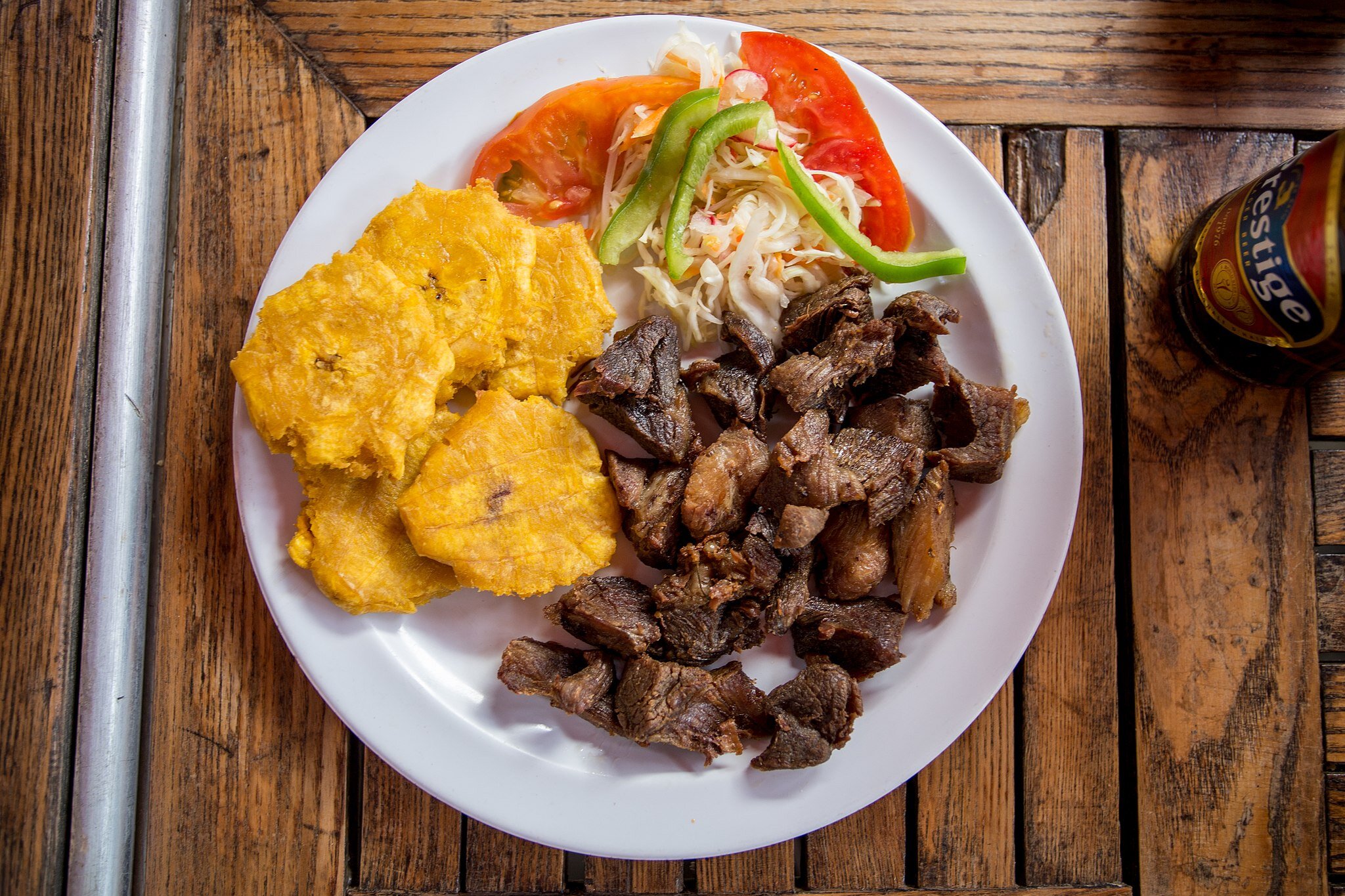A History of Haitian Food
By Noah Augustin
Griyo is Haiti’s national dish. Here, it’s served with plantain and pikliz. Image courtesy Lëa-Kim Châteauneuf, CC BY-SA 4.0, via Wikimedia Commons.
Have you ever had a meal and wondered how that dish was invented or been somewhere and asked how their style of cooking came to be? That is exactly what food history is all about.
I am a Haitian-American, so I grew up eating Haitian food. At family gatherings, on holidays or just dinner cooked by my dad, Haitian food is a big part of my life. Many of my family members, especially my dad, have told me stories about Haitian history and the history of Haitian food, and today I will be sharing some of this knowledge with you.
Griyo and Diri Kole ak Pwa Wouj
In West Africa, Griots recount stories and songs. This Griot is from Senegal. Photo courtesy A Wolof xalamkat - Dakar, Senegal, Public domain, via Wikimedia Commons.
Griyo is the national dish of Haiti. It is made by washing pieces of pork shoulder in lemon or lime juice and marinating it in a Haitian spice mix (epis). Then it is fried. It is most commonly served with diri ak pwa wouj (red beans and rice) and pikliz (pickled cabbage and scotch bonnet peppers) or with fried plantain.
In West Africa, Griots and Griottes are people who recount stories, sing and play music. In West Africa, Griots are of very high social status. A theory about why this dish was named after these African storytellers is because Haitian griyo was reserved for the highest-class Haitian citizens and for tourists because of the price of this cut of pork. This reflects how African Griots were of very high class in society.
Over time, more and more people started making it. When Haitians started migrating to the U.S. and opening Haitian restaurants, Americans as well got an appetite for the fried delicacy.
But Griyo alone isn’t a meal which is why we need diri ak pwa wouj. Red beans and rice is often associated with Louisiana and Creole cuisine, but it was originally a very common African dish. So when the French brought enslaved Africans to Haiti, they brought this with them along with many other things such as okra, pigeon peas, ackee, taro and various spices, which are all used in Haitian cooking to this day.
After the Haitians won the revolution many of the remaining whites and formerly enslaved people who didn’t want to be a part of the new nation fled to Louisiana because it was the strongest nearby French settlement at the time. Those formerly enslaved people were the ones who introduced red beans and rice along with many other aspects of Creole cooking to the U.S. South.
That is the story of Griyo and Diri ak Pwa wouj. On to our next dish.
Soup Joumou
Soup joumou is prepared by pureeing squash or pumpkin and adding it to either chicken or vegetable broth. Many people add leftovers from Christmas or New Year’s dinner along with pasta, potatoes and many other things. Image courtesy Aliceba, CC BY-SA 4.0, via Wikimedia Commons.
Soup or “bouillon” is a Haitian super food! It tastes good, you can put pretty much anything in it, it makes you feel better when you’re sick, and it is very nutritious. Therefore it plays a big part in keeping many families in Haiti well-fed and healthy.
But the soup that I’m going to be talking about today is very special. Soup joumou (pumpkin soup) is one of the dishes that we take a lot of pride in.
After the French colonized Haiti, they didn’t only make enslaved people work on plantations, but also as janitors, babysitters, gardeners, construction workers and most importantly, as cooks. One of the things these enslaved people cooked was pumpkin soup.
But the rule was that they were not allowed to taste the soup under any circumstances. Later they were left to eat the scraps.
Once the Haitians won the revolution, they claimed this dish for themselves. Now every year on January 1st we eat this dish to celebrate our independence that we gained that same day in 1804.
Soup joumou is prepared by pureeing squash or pumpkin and adding it to either chicken or vegetable broth. After that, you can put whatever you want in it. Many people add leftovers from Christmas or New Year’s dinner along with pasta, potatoes and many other things.
Finally, how can you talk about a country’s cuisine without mentioning the best type of food, dessert?
Dous Makos and Fresco
Many people believe Haitian culture is solely influenced by the French, but this is not true. Over the years people from many different countries have migrated to Haiti.
In the 18th and 19th centuries, these included Germans, Polish, Spanish, Portuguese, Romanians, Dutch, Danish, Curaçaoan, Lebanese, Syrian and Egyptian people. During World War II many Romanian, German, Czech and Polish Jews came to seek protection. Haiti played a small but important role in protecting Jewish refugees.
All of these countries have helped in the process of shaping Haitian culture. Today I will be talking about two desserts that have been brought to Haiti by these countries, starting off with dous makos.
Dous makos (sweet makos) is the only Haitian candy that has ever been mass manufactured and distributed. It is a type of fudge candy that was invented in 1939 in a town called Petit-Goave by Ferdinand Makos, hence the name. He was a Belgian-Haitian entrepreneur, and he was the one to create this dessert and to make a company out of it. It is very similar to Spanish Turron which he used as inspiration.
Dous makos is a fudge that usually has three stripes, each one of them a different flavor. Unlike turron that is usually only made with almonds, dous makos can be flavored with many things such as rum, cinnamon, vanilla, chocolate, peanut butter or almonds. This is considered to be Haiti’s national dessert. But if you’re looking for a more refreshing Haitian treat then fresco is the thing for you!
Another people who migrated to Haiti were the Italians. They came around the same time as the Germans and Polish, in the 19th century. At that time, the business sector of Haiti was controlled by the Germans and Italians, but unlike the Germans who established their own town, Bombardopolis, the Italian population mostly stayed in the capital of Port-au-Prince. They didn’t only bring their knowledge of business and the market, they also brought some culinary insight with them! One of the things that they introduced to Haiti is fresco, or as we Americans call it, Italian ice.
In Italy, this sorbet-like dessert is called granita. It is originally from Sicily, where it is a common dessert that is sold throughout the island, often with coffee and roasted almonds.
Unlike the Sicilians who sometimes prepare granita by crushing ice and sometimes by shaving it, Haitians always prepare fresco by shaving a block of ice. Also, in Sicily, granita is flavored with mulberry, strawberry, blackberry, jasmine, orange, mint or almond, but in Haiti it is flavored with fruits that are grown in the country such as mango, guava, soursop, pomegranate or passion fruit.
Fresco is usually sold by street vendors with roasted peanuts on top and it is a common treat for kids and grown-ups alike on very hot days. There is so much information about Haitian cuisine that you could write a book about it, but these are a few of my favorites. Thank you very much for reading, and I hope that maybe I have encouraged you to learn more about the beautiful Caribbean island of Haiti.



